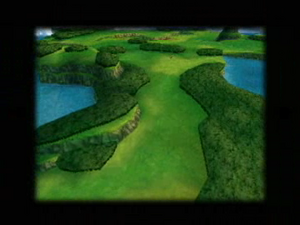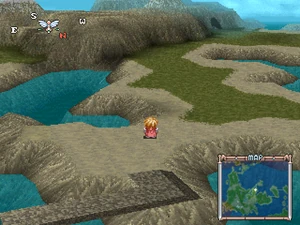
The World Map in Tales of Innocence.
The Overworld Map, otherwise known as the World Map and Field Map, is a common feature in the Tales series. Not to be confused with a game's basic geographical map, the overworld map refers to the openly-explorable terrain exclusive to titles prior to Tales of Graces, which introduced dungeon-like areas known as Field Locations that feature terrain reminiscent of the world map. Subsequent titles have mirrored this feature, with Tales of Vesperia being the last title to feature an overworld map, though Tales of Hearts R reintroduced the expansive world map system.
Appearances in Original Titles[]
Tales of Phantasia[]

The World Map in Tales of Phantasia (PSX).
Tales of Phantasia introduced the world map as a means of travel among locations. While the Super Famicom release of the game and the Game Boy Advance port both feature two-dimensional location monuments, the PlayStation release implemented three-dimensional field graphics that would later become the trend for future installments in the series. At a certain point in the game, the group obtains Rheairds, which allow for quicker transportation across the world map, and other quick-flight transportation methods are obtained in future games. While traveling normally on the world map, players can encounter enemies just as they would in dungeons. In the upper-right corner of the world map screen is a compass, while the bottom-right corner features a representation of the player's location on the world map.
Tales of Destiny[]
In the original PlayStation release of Tales of Destiny, the world map, alternatively known as the Global Sphere Map (グローバルスフィアマップ?), is rendered as a three-dimensional sphere with unwalkable terrain such as mountains, pits, and oceans. Transportation on the world map includes standard movement on the ground, several predetermined routes through the sea within a cruise ship, flight within the Draconis airship, and even a "Tricycle" option that reduces movement speed on the world map while preventing all enemy encounters. While piloting the Draconis, it is possible to rotate the map and travel in directions that are not possible from the ground, such as diagonal movement.
In the bottom-left corner of the world map screen is the Active Party Window (アクティブパーティウィンドウ?), in which the characters of the active battle party are shown in close detail. If the player idles in one position without moving after a set amount of time, the characters begin to move within this screen, first posing for the player, then performing various actions such as dancing or reading books. In the Japanese release of this game, this window serves as a way for the characters to chat with each other, talking about personal matters that do not relate to the story as a way to provide interaction between characters who would otherwise have no reason to speak with each other. This function acts as the precursor to the skit systems that are found in all later games in the series. However, all chat dialogue was removed from the English release of the game due to the lack of English voice actors.
In the remake and Director's Cut versions of the game, the world map is fully rendered in three-dimensional polygon graphics, including a simplified, three-dimensional model of the character avatar that represents the party. Camera view can be rotated freely to both sides, and the camera zooms in or out automatically to prevent terrain from obstructing the player's view of the character. Zoom functions cannot be controlled directly by the player. This method of world map display originated with Tales of Destiny 2, and the graphics style was taken directly from that game as an homage to the relationship between the stories of the two games. Transportation on the world map includes standard movement on the ground, ocean travel within a Sea Dragon vessel, and flight within the Draconis and upgraded Lumina Draconis airships.
Tales of Symphonia[]
Tales of Symphonia was the first game in the series to break away from random encounters, instead having visible enemies on both the world map and within dungeons. This feature skips Tales of Rebirth and Tales of Legendia, not appearing again until Tales of the Abyss. These enemies are given a variety of forms within dungeons, but on the world map, they only appear in two forms of shaded, unidentifiable creatures. This makes it impossible to determine what enemies the battle party will fight, but the map's terrain determines what classes of enemies may appear. For example, if an enemy is encountered on a visible road, the opponents in battle will always be human characters. Like its distant sequel, Symphonia makes use of the Rheairds for quick air travel, as well as cross-dimensional travel between the worlds of Sylvarant and Tethe'alla. The game's closer sequel, Tales of Symphonia: Dawn of the New World, relinquishes the world map feature altogether, instead providing a primitive, selection-based method of travel.
Tales of Legendia[]
Tales of Legendia takes place primarily on the large ship known as the Legacy, which serves as the game's world map. Due to having few settlements and a plethora of dungeons, the game introduces the Duct system, which allows for the player to travel by means of instant teleportation if the Duct in that particular area has been activated. Unlike other games with world maps, there is no means of air travel in Legendia.


